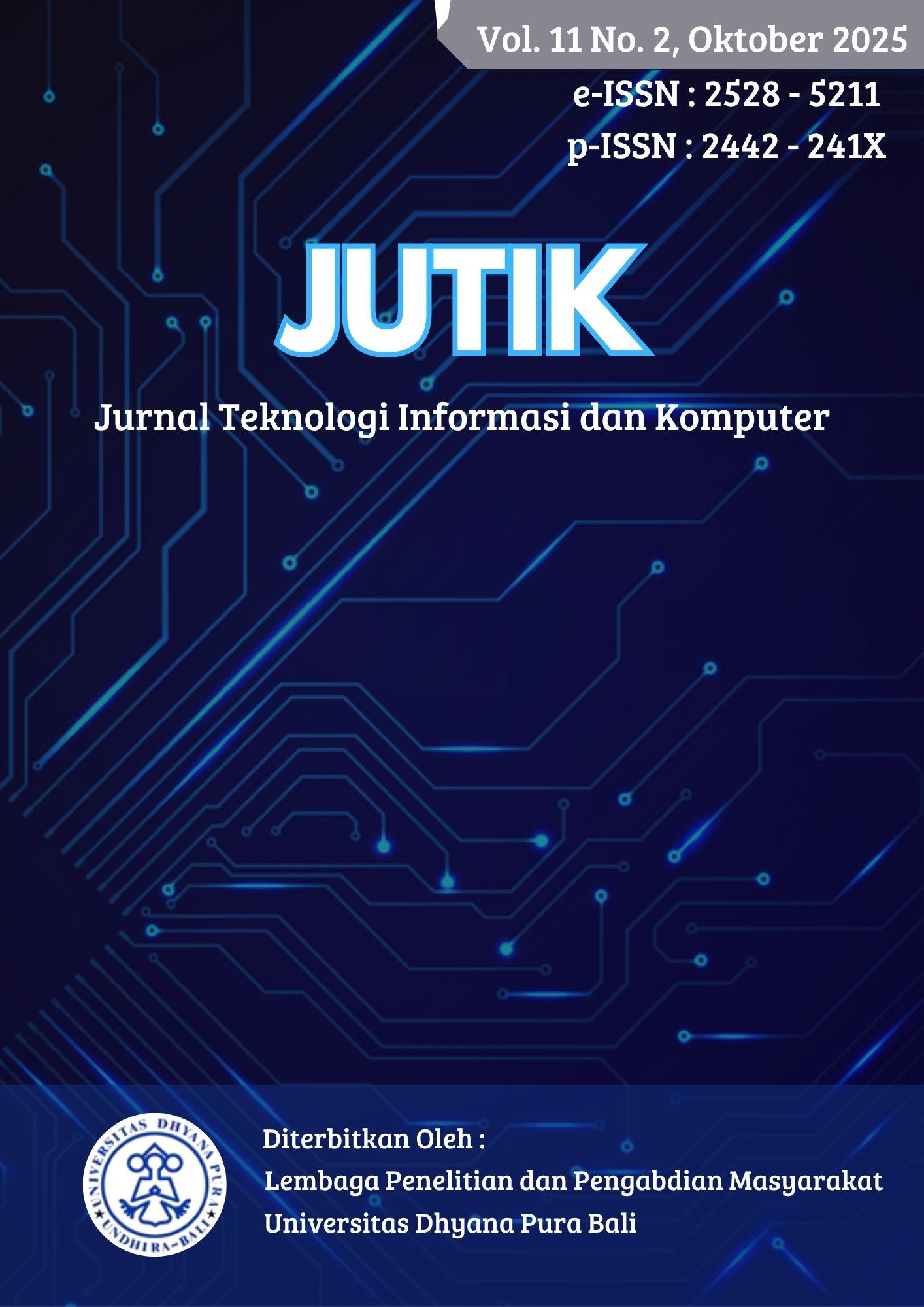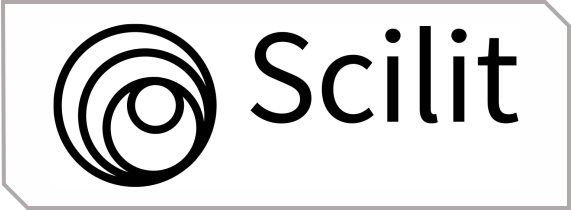ANALISIS KINERJA ARSITEKTUR CNN ALEXNET DAN VGG16 UNTUK KLASIFIKASI TUMOR OTAK
DOI:
https://doi.org/10.36002/jutik.v11i2.3900Keywords:
Alexnet, Brain Tumor Classification, CNN, MRI, VGG16Abstract
Early detection of brain tumors is essential for determining appropriate treatment strategies and increasing patient survival rates. This study analyzes and compares the performance of two Convolutional Neural Network (CNN) architectures Alexnet and VGG16 for classifying brain tumor MRI images into three categories: glioma, meningioma, and pituitary. The dataset, annotated by medical experts, was split into 80% for training and 20% for testing. Each image underwent preprocessing steps including resizing, normalization, and data augmentation. Both models were initialized with pre-trained weights from ImageNet and trained for 15 epochs using the Adam optimizer. Model performance was evaluated using accuracy, precision, recall, and F1-score metrics. The results show that Alexnet achieved a testing accuracy of 78.99% with a weighted F1-score of 0.79, while VGG16 obtained an accuracy of 78.01% and a weighted F1-score of 0.75. Although VGG16 has a deeper architecture capable of capturing more complex features, Alexnet demonstrated more stable and balanced performance across all tumor classes. These findings suggest that Alexnet is more effective for classifying brain tumor MRI images within the evaluated dataset and holds strong potential for integration into medical decision-support systems based on deep learning.
References
[1] A. Chinga, W. Bendezu, and A. Angulo, ‘Comparative Study of CNN Architectures for Brain Tumor Classification Using MRI: Exploring GradCAM for Visualizing CNN Focus’, Engineering Proceedings, vol. 83, no. 1, Art. no. 1, 2025, doi: 10.3390/engproc2025083022.
[2] S. Suganyadevi, V. Seethalakshmi, and K. Balasamy, ‘A review on deep learning in medical image analysis’, Int J Multimed Info Retr, vol. 11, no. 1, pp. 19–38, Mar. 2022, doi: 10.1007/s13735-021-00218-1.
[3] C. Chen, N. A. Mat Isa, and X. Liu, ‘A review of convolutional neural network based methods for medical image classification’, Computers in Biology and Medicine, vol. 185, p. 109507, Feb. 2025, doi: 10.1016/j.compbiomed.2024.109507.
[4] S. Srinivasan, D. Francis, S. K. Mathivanan, H. Rajadurai, B. D. Shivahare, and M. A. Shah, ‘A hybrid deep CNN model for brain tumor image multi-classification’, BMC Med Imaging, vol. 24, no. 1, p. 21, Jan. 2024, doi: 10.1186/s12880-024-01195-7.
[5] S. S. Kshatri and D. Singh, ‘Convolutional Neural Network in Medical Image Analysis: A Review’, Arch Computat Methods Eng, vol. 30, no. 4, pp. 2793–2810, May 2023, doi: 10.1007/s11831-023-09898-w.
[6] S. Kollem et al., ‘AlexNet-NDTL: Classification of MRI brain tumor images using modified AlexNet with deep transfer learning and Lipschitz-based data augmentation’, International Journal of Imaging Systems and Technology, vol. 33, no. 4, pp. 1306–1322, 2023, doi: 10.1002/ima.22870.
[7] M. A. E. Muhammed, A. A. Ahmed, and T. A. Khalid, ‘Benchmark analysis of popular ImageNet classification deep CNN architectures’, in 2017 International Conference On Smart Technologies For Smart Nation (SmartTechCon), Bangalore: IEEE, Aug. 2017, pp. 902–907. doi: 10.1109/smarttechcon.2017.8358502.
[8] S. Montaha et al., ‘BreastNet18: A High Accuracy Fine-Tuned VGG16 Model Evaluated Using Ablation Study for Diagnosing Breast Cancer from Enhanced Mammography Images’, Biology, vol. 10, no. 12, Art. no. 12, Dec. 2021, doi: 10.3390/biology10121347.
[9] A. Sharma and S. Arora, ‘Brain Tumor Detection using CNN and VGG-16 Model’, International Journal of Intelligent Systems and Applications in Engineering, vol. 12, no. 3, Art. no. 3, Jun. 2024.
[10] C. Srinivas et al., ‘Deep Transfer Learning Approaches in Performance Analysis of Brain Tumor Classification Using MRI Images’, Journal of Healthcare Engineering, vol. 2022, no. 1, p. 3264367, 2022, doi: 10.1155/2022/3264367.
[11] A. Nag et al., ‘TumorGANet: A Transfer Learning and Generative Adversarial Network- Based Data Augmentation Model for Brain Tumor Classification’, IEEE Access, vol. 12, pp. 103060–103081, 2024, doi: 10.1109/access.2024.3429633.
[12] J. Su, X. Yu, X. Wang, Z. Wang, and G. Chao, ‘Enhanced transfer learning with data augmentation’, Engineering Applications of Artificial Intelligence, vol. 129, p. 107602, 2024.
[13] Y. Deng et al., ‘Deep transfer learning and data augmentation improve glucose levels prediction in type 2 diabetes patients’, NPJ Digital Medicine, vol. 4, no. 1, p. 109, 2021.
[14] M. S. Ullah, M. A. Khan, A. Masood, O. Mzoughi, O. Saidani, and N. Alturki, ‘Brain tumor classification from MRI scans: a framework of hybrid deep learning model with Bayesian optimization and quantum theory-based marine predator algorithm’, Front Oncol, vol. 14, p. 1335740, Feb. 2024, doi: 10.3389/fonc.2024.1335740.
[15] N. E. Khalifa, M. Loey, and S. Mirjalili, ‘A comprehensive survey of recent trends in deep learning for digital images augmentation’, Artif Intell Rev, vol. 55, no. 3, pp. 2351–2377, Mar. 2022, doi: 10.1007/s10462-021-10066-4.
[16] E. Goceri, ‘Medical image data augmentation: techniques, comparisons and interpretations’, Artif Intell Rev, vol. 56, no. 11, pp. 12561–12605, Nov. 2023, doi: 10.1007/s10462-023-10453-z.
[17] A. Anaya-Isaza and L. Mera-Jiménez, ‘Data augmentation and transfer learning for brain tumor detection in magnetic resonance imaging’, IEEE access, vol. 10, pp. 23217–23233, 2022.
[18] Y. N. Fu’adah, I. Wijayanto, N. K. C. Pratiwi, F. F. Taliningsih, S. Rizal, and M. A. Pramudito, ‘Automated Classification of Alzheimer’s Disease Based on MRI Image Processing using Convolutional Neural Network (CNN) with AlexNet Architecture’, J. Phys.: Conf. Ser., vol. 1844, no. 1, p. 012020, Mar. 2021, doi: 10.1088/1742-6596/1844/1/012020.
[19] D. Nurani, I. L. Yanuar, and A. D. Putra, ‘Klasifikasi Jenis Penyakit Pada Citra Daun Padi Menggunakan Algoritma Convolution Neural Network’, Jurnal Teknologi Informasi dan Komputer, vol. 8, no. 3, Oct. 2022, doi: 10.36002/jutik.v8i3.2074.
Downloads
Published
How to Cite
Issue
Section
License
Copyright (c) 2025 JUTIK : Jurnal Teknologi Informasi dan Komputer

This work is licensed under a Creative Commons Attribution-NonCommercial-ShareAlike 4.0 International License.
![]()
This work is licensed under a Creative Commons Attribution-NonCommercial-ShareAlike 4.0 International License.











